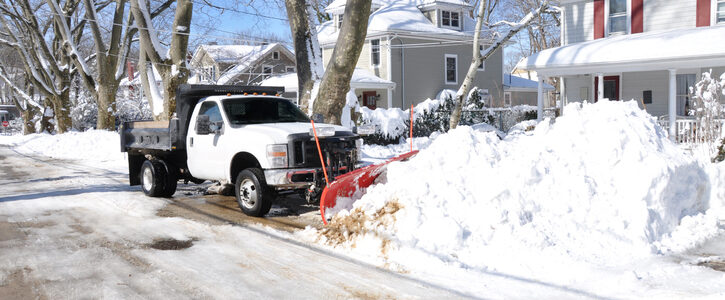If the winter of 2022-23 has taught us anything, it is Mother Nature is capable of dumping a considerable amount of snow within a short period. Ask the businesses that operate in and around Buffalo, as well as the Sierra Nevada Mountain range in California, about how significant snowfalls can disrupt daily routines.
Businesses implement several measures to ensure the safety of employees, customers, and visitors. However, snow plowing safety is not always something that receives the attention it deserves during weekly or monthly safety meetings. Snow plow operators that are responsible for snow removal of commercial properties need to take into account many factors in order to protect themselves and others from the potential harm falling from the sky.
Plowing Safety Tips Before Plowing
Before the first truck departs from the garage, your drivers can enhance the safety of employees, customers, and visitors by following a few standard tips.
The first step of the plowing preparation process involves dressing for the elements. Just because drivers sit behind the steering wheels in comfortably warm trucks does not mean they are not vulnerable to the dangers of winter weather. Encourage snow plow operators to dress in layers to trap the warmth generated by a properly heated vehicle, as well as always wear slip-resistant shoes and a commercial-grade reflective safety vest.
Teach snow plow operators about the three points of contact rule, which prevents slipping and falling whenever a snow plow operator has to leave the cab to address a snow-clearing issue. The three points of contact require snow plow operators to have at least three of their four limbs in contact with a stable surface. For example, holding on to the door of a cab with two hands and having at least one foot firmly implanted on the ground meets the three points of contact rule.
Although snow plow drivers often have to leave their cabs, they should always attach the seatbelt and any other type of safety harness that keeps them stabilized in the driver’s seat. Before setting out on a plowing mission, each driver should ensure they have a clear view of what is around them, as well as clearing any winter precipitation from both the front lights and taillights.
Plowing Safety Tips When Plowing
If your snow plow operators need to transport a snow plow to reach a certain destination, angle the blade of a snow plow towards the curb to decrease the safety risk of a blade catching a curb or a large snowbank. Never turn on a snow plow when transporting it to a job site, which means keeping the plow control feature off to prevent accidental activation of the starter switch.
For speed safety, never transport a snow plow at more than 40 miles per hour, and do not operate a snow plow at more than 15 miles an hour. Check the temperature gauge frequently to prevent overheating, which can significantly damage the engine. If overheating becomes a problem, pull over and adjust the position of the blade to create more airflow to the radiator.
The operators of your company’s snow plows should be familiar with obstacles that can derail a mission to clear snow. Obstacles to remember include the positions of curbs, speed bumps, fire hydrants, and water drains. When moving a snow plow in reverse, drivers should not rely solely on rear and side mirrors. Instead, they should turn around and look to verify the area around the snow plow is clear of obstacles.
After finishing a snow plowing mission, operators should lower the blade to ground level and turn the plow control off to reduce the operating stress on the hydraulic system.
Plowing Safety Tips at Night
Snow emergencies happen at all hours of the day, including at night when a driver’s vision is especially compromised. Although following traffic laws is an integral safety tip, it is an even more important safety tip to follow at night. It can be easy to dismiss basic safety guidelines at night when the roads are empty, but snow plow operators must remain just as focused at night as they are during the day to prevent accidents from unfolding.
Make sure every warning light functions at optimal levels to alert pedestrians and other drivers about the presence of your company’s fleet of snow plows. Maintain more distance between a snow plow and other vehicles at night than what the standard distance guidelines state for day driving. Pay attention to parked cars, particularly vehicles that have stalled on the road because of winter weather issues.
Be prepared to address unexpected mechanical breakdowns at night, such as stocking every company snow plow with emergency warning lights and a portable heater to prevent the development of dangerous hypothermia.
The Bottom Line
Practicing snow plow safety can have a direct impact on the cost of insurance by reducing the number of accident and liability claims. Before snow and ice turn your community into a skating rink, educate your company’s snow plow operators about the safety tips that ensure they protect themselves, as well as anyone who encounters their vehicles during a plowing mission.
There for You: Acadia Insurance
At Acadia, we’re all about helping businesses throughout the Northeast thrive. Our mission is to provide superior service and product as close to you as possible, providing you with the backing you need to proceed with confidence.
We understand what you want most from your insurance is security and peace of mind. That means knowing you are backed by an insurance company who will support you every step of the way to help you protect your business.
With Acadia, not only can you get coverage tailored to your needs, but you will also receive support from dedicated claims professionals to guide you through the claim process in the event of a loss. That way, you know exactly what to expect. Knowing your claims professional by name and a hand shake – that’s “Closer Coverage”. Get to know more about how we work and find an agent near you.
Acadia is pleased to share this material for the benefit of its customers. Please note, however, that nothing herein should be construed as either legal advice or the provision of professional consulting services. This material is for informational purposes only, and while reasonable care has been utilized in compiling this information, no warranty or representation is made as to accuracy or completeness. Recipients of this material must utilize their own judgment in implementing sound risk management practices and procedures.




